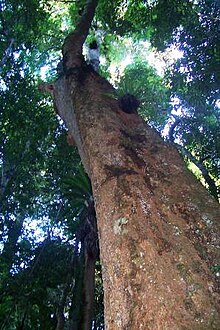| Didymocheton fraserianus | |
|---|---|

| |
| At Boorganna Nature Reserve, Australia | |
| Scientific classification | |
| Kingdom: | Plantae |
| Clade: | Tracheophytes |
| Clade: | Angiosperms |
| Clade: | Eudicots |
| Clade: | Rosids |
| Order: | Sapindales |
| Family: | Meliaceae |
| Genus: | Didymocheton |
| Species: | D. fraserianus
|
| Binomial name | |
| Didymocheton fraserianus | |
| Synonyms[4] | |
|
List
| |
Didymocheton fraserianus, commonly known as rosewood or rose mahogany,[5] is a medium-sized to large tree native to New South Wales and Queensland. It is widely used with the purpose of street design and to provide shade in the eastern suburbs of Sydney. Rosewood ranges from the rainforest around eastern Australia from Bundaberg in Queensland to Wyong in New South Wales. At maturity, it can reach a height of 57 metres (200 ft). It is generally known for its strong scent of rose from its bark.
Rosewood is a highly adaptable plant. It can grow in different site conditions, growing close to mountain ranges, basalt, and the volcanic basin. The species can also tolerate drought, frost, and salt. It is a typical long-lived but slow-growing species at the beginning. However, satisfying the growing condition of suitable temperature, humidity, and fertile soil can speed up its growth. Also, it is used commercially for the quality of its wood, in building high-end furniture and construction.[6][7] Further studies have also been conducting, focusing on exploring more about its usage in essential oil.[8]

- ^ "Dysoxylum fraserianum". IUCN Red List of Threatened Species. 2020. 2020. Retrieved 3 May 2021.
- ^ "Didymocheton fraserianus". Plants of the World Online. Retrieved 16 February 2024.
- ^ a b c "Dysoxylum fraserianum". Australian Plant Census. Retrieved 20 May 2021.
- ^ Didymocheton fraserianus (A.Juss.) Mabb. & Hauenschild. Plants of the World Online. Retrieved 16 February 2024.
- ^ Cite error: The named reference
FoAwas invoked but never defined (see the help page). - ^ Nicholson, Nan; Nicholson, Hugh. Australian Rainforest Plants. Terania Rainforest Publishing.
- ^ Cite error: The named reference
:8was invoked but never defined (see the help page). - ^ Cite error: The named reference
:9was invoked but never defined (see the help page).
